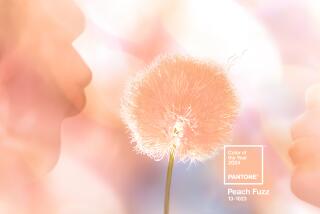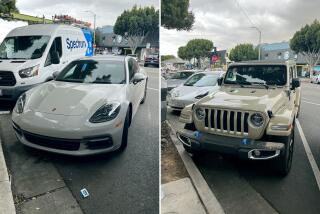Tell-all hues reveal the nation’s mood
- Share via
1900s-1910s: Stained-glass lamps by designer Louis Comfort Tiffany introduce an Impressionistic touch of watery blues and milky pastels to the predominant mix of rich reds, purples and greens. The latter are residuals of the Victorian era that take out the chill of high-ceilinged rooms.
1920s: After World War I, Scottish architect Charles Rennie Mackintosh’s white movement represents cleanliness and a first step into modernism. Later, Art Deco pairs industrial whites, blacks and grays with brilliant colors.
1930s: Frank Lloyd Wright’s Southwestern hues, including natural wood tones and Cherokee red, connect interiors to the terrain.
1940s: World War II brings color rationing; grays and khakis, as well as patriotic reds and blues, dominate.
1950s: A postwar feminine trend continues with the “I Love Lucy” period. Soft roses, sherbet pinks, minty greens and pastels color everything from bathrooms to Buicks. Near decade’s end, autumnals such as chestnut orange and faded chartreuse become popular -- and are combined, somewhat incongruously, with Jet Age designs.
1960s: A revved-up economy and focus on youth encourage bright Pop Art colors and denim blue.
1970s: Concerns about the environment revive natural hues, especially beige, avocado green, harvest gold, rust and orange.
1980s: High-tech equipment translates to black, white and gray interiors, with shots of burgundy and mauve. “Barbara Bush” blue, “Miami Vice” pink and teal, and Georgia O’Keeffe’s Southwestern colors all have their moments in the sun.
1990s: Early on, the ribbons of the Persian Gulf War and the blockbuster film “Dick Tracy” popularize bright yellows. When recession hits, safe beiges and off-whites come back into vogue. In the mid-’90s, designer wall paints by Ralph Lauren and Martha Stewart are all the rage. By decade’s end, the introduction of Apple’s iMac computer reboots the popularity of fruity colors such as blueberry and tangerine.
Turn of this century: Urban Gen-Xers turn to complex pairings such as bitter chocolate next to yellow-green. After Sept. 11, subtle blues and military shades resurface. Muted colors hint at the popularity of yoga and the metaphysical.
*
Sources: Margaret Walch, Color Assn. of the United States and coauthor of “Living Colors: The Definitive Guide to Color Palettes Through the Ages” (Chronicle Books, $30); Leatrice Eiseman, Pantone Color Institute; Murray Bartlett Douglas, Brunschwig & Fils.
Researched by Melissa Milios and Janet Eastman.


